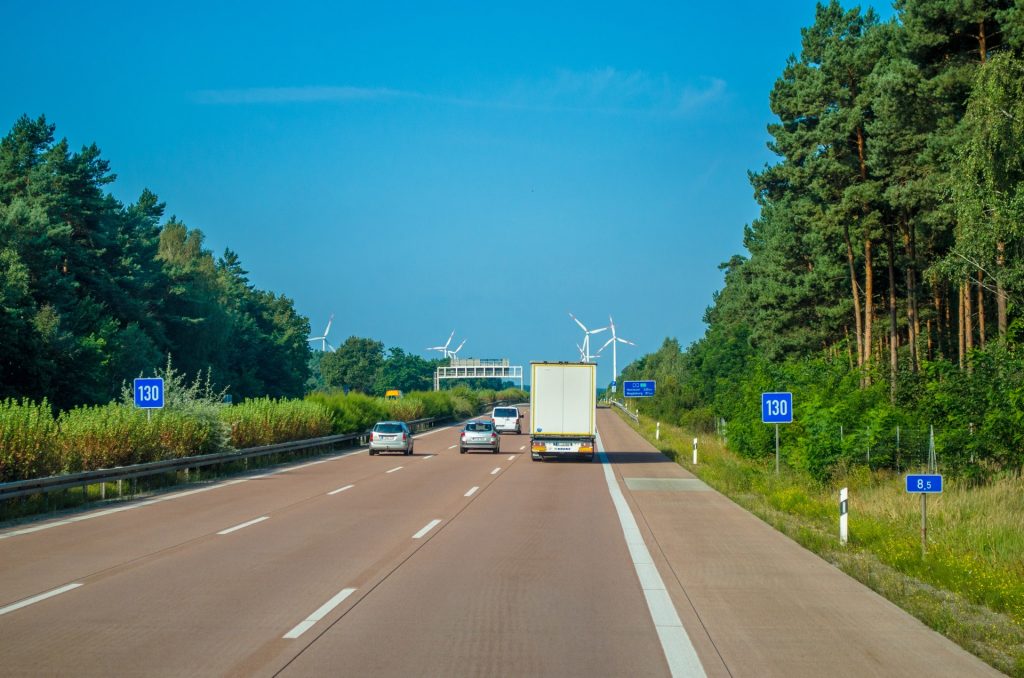Stay Cool in Summer: Top 10 Tips for HGV Drivers
As the summer months begin, temperatures start to rise and with 2018 being the UK’s joint hottest summer on record, it’s likely we will see another heatwave in the future. Long-haul journeys can be harder for HGV drivers to manage in the heat, with the risk of dehydration, sunburn and vehicle malfunctions increasing.
However, the temperature isn’t the only thing to worry about at this time of year. Better weather means more drivers on the road and, last year, an analysis of telematics data discovered that drivers are 21% more likely to speed during the summer months and that 10% of the annual speeding convictions were noted in June.
With these points in mind, we have compiled a top 10 list of ways for HGV drivers to stay cool in the summer.

Drink plenty of water
The hotter it is, the more you sweat and that leads to a loss of body fluids, which have to be topped back up by regularly drinking water. Doing this also helps lower your body temperature, keeping you cooler in the heat.
However, if these fluids aren’t replaced, it can lead to dehydration and even mild dehydration can cause nausea, stomach upset, fatigue and dizziness. This can cause lowered concentration levels which will be dangerous for you as a driver, as well as the other motorists around you, so it’s important to stay on top of this during the hot summer months.
Ensure that you are well hydrated beforehand and that you’ve got a healthy supply of water in your HGV when you set off for your journey. You can also freeze some bottles to use as ice packs, letting them defrost during your journey to keep them as cold as possible for drinking later on.
Beware the glare
Driving in the summer months also means there is a greater risk of having your vision impaired by the sunlight, especially if you’re driving towards it. This can be distracting and may cause you to have longer reaction times to issues on the road.
All drivers should make sure they have a pair of glasses, which will also protect eyes from harmful UV rays, on hand to keep their vision glare-free.
Wear sun cream – even inside your truck
Continuing on from the point above, increased UV rays also means a higher risk of sunburn — even if you’re sitting in your truck. It may only be some of your body getting a ‘trucker’s tan’, but consistent sun exposure to the same area can be dangerous and you should still have all of your skin protected from it. Make sure that you have good sun cream that protects from both UVA and UVB rays, this article from T3 has several good options.
Prepare your HGV
The heat can be difficult to deal with for us as humans, but it can also lead to issues with vehicles, like your HGV, as well. Keep an eye out for these common problems that could arise in the heat:
- Tyre blowout – Hot weather can be a big problem for tyres. As everything heats up around them (the air, the tarmac and the external metal), the risk of blowout increases as tyres build up heat and pressure very quickly. If a tyre should heat up to over its design specifications, this is when a blowout can occur. There’s not really much you can do to ensure that your tyres stay cool, but you can ensure that they are properly inflated to manufacturers’ specifications as under-inflated tyres also increase the risk of tyre blowouts.
- Brake fade – It’s common knowledge that cold weather can impact your brakes, however, hot weather can also negatively affect the performance of your brakes. When brakes are activated, they cause friction which results in heat and when the outside temperatures are already warm, this heat can be far more significant and far more difficult to reduce. This can lead brakes to become unpredictable, lose their effectiveness or fail entirely. To avoid this, ensure your brake fluid isn’t too old, that your pads are in good condition and that you leave plenty of time to slow down before braking when you can.
- Check the cooling elements – The cooling system should be in top working order before setting off on a journey to avoid the risk of overheating, low coolant can be a cause of this. The radiator reduces heat from the engine and is fitted with a tank that will make room for the expansion of the coolant when temperatures are higher. However, when the engine is cold, you must ensure that this coolant is topped up enough for your journey. Another cooling element is the fan, a seized cooling fan is the most common initial cause of overheating and you should be able to test this by letting the vehicle idle for 5 minutes with the heater off. The fan should kick in automatically and if it doesn’t it’s worth getting it checked.
Be aware of other motorists
Warm weather and summer holidays lead to increased traffic on the roads as people go on day trips or long-haul drives. Unlike HGV Drivers, these motorists aren’t professionals and are more likely to become tired, irritable and easily confused or distracted as they drive unfamiliar routes. This could lead them to make sudden and unsafe moves on the road, which you will have to accommodate for. When driving in built-up areas, like motorways and city centres, be cautious of the drivers around you and take extra measures to be safe.

Better weather means more roadworks
The increase of people on the roads won’t only come from there being more summer holiday traffic, with better weather, it also means that more civil engineers will be on the roads too.
According to research by Adzuna, civil engineering is one of the deadliest jobs in the UK at the moment — with 20 civil engineers dying in the workplace in 2017 due to heavy machinery or being struck by vehicles. The job is already risky for these workers and over the past 10 years, there have been over 50 incidents of road workers being injured by motorists. With a higher likelihood of you having to navigate through roadworks, be mindful of the workers close to your truck, stay alert, heed warning signs and slow down in construction zones.
Take advantage of the air-con
If you have a working air con unit in your vehicle, make the most of it during the summer months. Heat can make you feel drowsier and if you’re stuck in a long line of traffic with little driving action to take, it can get to you. The Highway code recommends a blast of cold air to keep you awake when you’re feeling drowsy (cooling you down will also be a bonus too).
If you don’t have aircon and you’re happy with the wind whipping around in the truck, you can also wind down the window to get some cooler, fresh air. However, be mindful that this will increase drag and impact your fuel consumption.
Dress for the heat
Many haulage firms have a dress code or uniform that drivers are expected to wear, this could consist of jackets, polo shirts, high-vis clothing and even waterproofs. Though some firms may accommodate for summer clothing in their uniforms, items like waterproofs or high-vis jackets may be a little heavy duty for summer wear and could leave you over-heated and uncomfortable during journeys.
In extreme heat, and if it is okay with management, ensure that you are wearing tidy but temperature-appropriate clothing like shorts and short sleeved t-shirts.
Don’t rely on the weather
In the UK, the weather is incredibly unreliable, it could be sunny one minute and then pouring with rain the next. With extreme heat in the UK, our warm summer spells are often followed by a downpour or a storm.
This is something to be prepared for, keep an eye on weather reports and ensure that your vehicle is well-maintained during the warm weather. As we have previously mentioned, your tyres and brakes can be impacted by the heat and should the weather turn, you could be going from dealing with sweltering temperatures one moment to water on the road the next.
Ensure you make the most of your break periods
In the heat, it’s easy to get tired as our body works overtime to try and make sure we stay cool. Therefore, it is important to make the most of your rest periods to stay refreshed but also to adhere to tachograph rules and regulations. Regarding driving hours and breaks, there are some key points:
- You may only drive for a maximum of 9 hours a day (however, you may drive for up to 10 hours no more than twice a week), followed by at least 11 hours of rest.
- You cannot drive for more than 56 hours a week, with the two-week limit being 90 hours over any two-consecutive weekly periods.
- A driver must take a 45-minute break for every 4.5 hours of driving unless they take a daily or weekly rest period. This could be comprised of a single period of 45 minutes or a single period of 15 minutes, followed by a single period of 30 minutes.

You can find out more about tachograph rules and regulations in our blog, ‘Digital Tachograph Rules to Keep In Mind’.
These industry regulations help HGV Drivers avoid exhaustion on the roads and will result in fines if they are not followed, however, these regulations should also be helpful in periods of extreme heat. If possible, use your break periods to go to a truck stop or petrol station to stock up your water supply, get some shade if you’ve been driving in direct sunlight all day, refresh yourself with fresh air and light movement (which will be particularly helpful if the heat is making you feel drowsy) or even top up your sun cream.
If you’re ever on the road in the heat and you’re looking for a place to stop during your rest period, you can check out our blog The best UK truck stops for resting HGV drivers for some great places to do so.
The summer can make driving a far more enjoyable experience, however, in cases of extreme heat, it can also make it difficult and dangerous. If you’re on the road during a heatwave this summer, try some of these tips. If you do, you can let us know on Twitter by tagging us at @stoneridge_uk.For more hints and tips on HGV driving, you can head to this section of our website, and if you would like some more information on our SE5000 Exakt Duo2 Digital Tachograph or about the introduction of Smart Tachographs in June 2019, you can head onto the Stoneridge Electronics website. Alternatively, you can contact us via phone or email.
